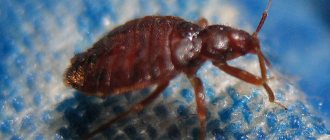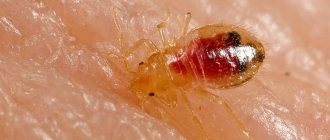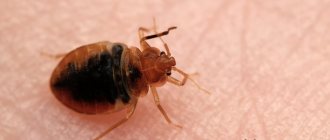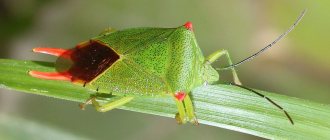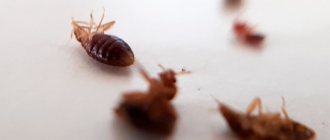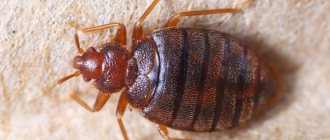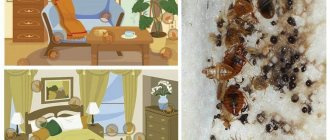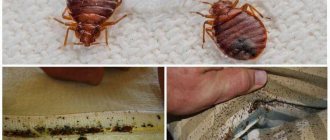- By Vil Malinoshevsky
- About bedbugs
Bed bugs are a very subtle and ambiguous issue. The fact is that if bedbugs hide in the bed itself - in the sheets, in the pillowcases of the pillows, inside the duvet covers - then there are always fewer of them here than in other places in the room. For example, look at where the main clusters of bedbugs are located in a heavily infested sleeping area in an ordinary apartment:
The situation with beds is similar: bedbugs can live and hide in a bed, but if there are a lot of them in the house, then here, in the bed, only a small part of the total number can be found. This is very important, because people often believe that since bedbugs, or, for example, bedbugs, it means that they only live in beds and beds, and if they are taken out only from the bed, then they can be gotten rid of forever .
In reality, only a small part of those bedbugs that constantly live in the apartment hide and constantly live both in the bed and in the bed. That is why those people who treat only the bed or only the bed, even with very effective means, cannot get rid of them. After this treatment, only those bugs that were on the bed will die. And everyone else will continue to bite safely, having emerged at night from their hiding places in other places in the apartment - from behind baseboards, from under linoleum and from under furniture.
Adult bedbugs on the seam of a mattress on a bed
This is one of the main mistakes when removing bedbugs from an apartment. If you understand well where they hide during the day, where to look for them and where to poison them, then getting them out, in principle, will not be a big problem. But this is only in theory. In practice there are many nuances. Now we will talk about the main points. Plus, we often receive questions by email regarding the removal and general detection of bed bugs in beds, and we will also answer the most common of them.
Feeding features of bedbugs
The blood of warm-blooded creatures is the only suitable food for parasites. These insects most often attack people. This is due to the fact that it is difficult for pests to penetrate the hard outer shell of animals and birds with their mouthparts. Human skin is softer and blood vessels are often located closer to the surface, making it even easier for pests to find food.
Domestic parasites of this species attack humans during sleep. They mostly do this at night, but bedbugs often bite a person while sleeping during the day, under special conditions, for example, when the victim is outside the house for a long time. The best time to eat is between 2 and 5 am. A person does not awaken from the weak activity of parasites, because sleep at this stage is the deepest.
Before eating, the insect injects saliva under the skin, which contains substances that anesthetic the bite. As a result, the person does not feel anything, and in the morning he discovers red spots.
The larvae do not yet have this ability, so their bites are painful.
How to detect the presence of bedbugs in the house
It’s easy to find out that there are bedbugs in your house or apartment if you know the main signs of their presence:
- The appearance of black dots on the bed linen, mattress, under the pillow - traces of insect feces, which look like traces of a felt-tip pen or black pen. Traces are washed off, and it is easier to detect bedbugs on light-colored bedding.
- Detection of eggs (empty or full), fragments of larval shells, which they shed, moving to the next stage of development.
- Traces of numerous bites. Bed bugs bite more than once, which is why multiple bites can be seen on one area of the skin. It is almost impossible to directly feel the moment of the bite, since during an attack the insect injects a “painkiller” under the victim’s skin.
A sudden inspection of the bed at night will help determine the presence of bloodsuckers in the house. Get up at 4-5 am, turn on the light in the room and examine the bed linen - if there are bedbugs, you will notice them.
How long can a bed bug live?
The persistence of bed bugs is a factor that scares many people. It is assumed that the insect can survive for a very long time without food, and contact with bedbugs is often completely useless. However, it is not.
As experts previously stated, the average life expectancy of a bedbug without food is up to 14 months, but only if it feeds (drinks) blood without long breaks. The bug bites a person several times at a time and receives the required amount of energy.
If there is no access to blood, insects live much shorter, but still quite long compared to other types of living beings.
Life expectancy of bedbugs without feeding:
| Insect age | Possible number of days without bleeding |
| Larva 1st stage | Up to 38 days |
| Larva 2nd stage | Up to 74 days |
| Larva 3rd stage | Up to 123 days |
| Larval stage 4 | Up to 132 days |
| Adult insect | Up to 99-106 days |
Without food, life expectancy is significantly reduced. For example, with normal nutrition, bedbug larvae hatch 5-10 days after laying eggs.
Without food, this period increases to 4 months, and the larvae simply “freeze” in their shells. Using various treatment methods, the lifespan of pests can be reduced to several days or even hours.
The influence of temperature and pesticides on the lifespan of insects
Under unfavorable conditions, the population declines noticeably after a few months, but recovers within 1-3 months after people return.
Bed bugs are most active at temperatures around +30°C, that is, indoor conditions are ideal for their development, since they are able to actively reproduce at temperatures from +10 to +40°C.
Moreover, these insects survive even at subzero temperatures. At -17°C they survive for 24 hours, but not at hot temperatures above 40°C.
In the past, bedbugs were removed by scalding with boiling water.
These parasites are quite resistant to pesticides. Each stage of development is characterized by its own survival rate (some 4th stage larvae can live without food for more than a month, others even after 120 days).
This is explained by the facts described by scientists who studied bed bugs from four different cultures. The results are as follows: two varieties of parasites are resistant to insecticides, the other two are sensitive.
The most pesticide-sensitive beetles were collected from laboratory-grown crops, while the resistant species were collected from hotels, apartments and areas where insecticide treatments are regularly carried out. Chemical resistance has been shown to directly affect how long bed bugs survive without feeding.
It is almost impossible to get rid of bed bugs without insecticides. However, you can additionally try to deprive the bloodsuckers of their food source.
For example, place the infested mattress or other items in an airtight cover to prevent the insects from escaping. Since bedbugs can remain without food for a long time, the lid should not be opened until after six months.
Bed bugs: how to get rid of them at home
To eliminate domestic bloodsuckers, you will have to work hard to ensure that your efforts are crowned with success in the shortest possible time. Every day of delay increases the number of insects, and insufficiently thorough treatment leads to the fact that surviving individuals become resistant to the insecticide used, and pass on such immunity to their offspring. You can destroy bedbugs using one of the following methods, or using a combination of them:
- Physical;
- Chemical;
- Folk;
- Professional.
Calling professional exterminators is not cheap, so they resort to it in extreme cases. People who have bed bugs choose how to get rid of them on their own from the first two groups, using folk remedies to prevent recurrence.
photo from the site https://dezins.ru/
How long can bed bugs live without food?
Parasites can survive for some time without food. Breaks between meals are the norm for them. After feeding, their body increases significantly in size and length (several times). The process of digesting the received portion of human body fluid takes some time. This releases enough energy for the reproduction and survival of parasites.
In addition, nature has provided a protective function - a transition to a special state in which all functions are slowed down, which allows the beetles to live much longer. This requires a number of conditions, including fasting.
The digestion process takes a very long time
Anabiosis as a means of survival without food
If the parasite remains without food for a long time, it goes into energy saving mode. All functions are reduced and processes are inhibited. This state is intermediate between deep sleep and suspended animation. The parasite does not die. However, he is in a similar state. The external resemblance of a parasite in suspended animation and a dead insect confirms the truth of these words.
The body of the bed bug is strongly flattened and resembles the dried chitinous shell of the larva, but is larger in size.
If you're wondering how long a bed bug can live without human blood, you should consider that the parasite can remain in a state of suspended animation for many months. However, these insects quickly come to life as soon as the victim is nearby. They focus on the smell of carbon dioxide released by the human body.
During hibernation, processes in the body slow down and the body becomes as flat as possible.
How long do bedbugs live without human blood?
If the victim is constantly nearby and regularly sleeps at home, the parasite can attack at least every day. However, the insect only needs food once every 5-10 days. This is the time during which the parasite can survive without the risk of severe starvation. The lifespan of such pests without access to a food source depends on their age:
- larva at the 1st stage of development (immediately after emerging from the egg) - up to 38 days;
- parasites at stage 2 - up to 74 days;
- bedbugs at the 3rd stage of development - up to 123 days;
- larvae at the 4th stage of development - up to 132 days;
- adult insects - up to 142 days.
When studying the question of how long bedbugs live, it turns out that parasites can survive without food for such a time only under normal conditions.
If the ambient temperature changes, the fasting period can be extended.
An adult who has eaten the maximum amount of food can wait 140 days for the next meal.
How long do bedbugs live in an empty apartment?
If parasites are left without food, they may starve for some time. The beetles are gradually slowing down. This leads to a state resembling suspended animation. As a result, the reproduction rate drops to zero because there is not enough energy to do so. Insects can spend from 10 months to 1.5 years in this state.
An important condition for this is maintaining a cool microclimate.
In addition, remaining in an empty apartment, the parasite has the opportunity to move to neighboring rooms, where it finds food. In a private house everything is much more complicated. In this case, the insect can remain isolated for a long time.
However, the bug will return the next day as soon as a person appears, because it will wake up and start drinking blood.
In an empty apartment, a bug can even move to neighbors to search for food.
Do bedbugs have life after disinfection?
Good news for those wondering how long bed bugs live after disinfection: from a few hours to 5-10 days, depending on how they were killed. It takes longer to kill the eggs as the insecticide penetrates the shell of the embryo. Not all insecticides kill eggs even on direct contact. Therefore, within 14 days the eggs have time to hatch, and the new generation is destroyed upon contact with the pathogen. Modern pest control methods make it possible to be 100% sure that no pest has a chance, but bed bugs can live in a building for up to 21 days after disinfestation.
Hoping that a colony of bloodsuckers will survive the months of life allotted to it by nature and die out naturally is a waste of time. The insect actively takes care of procreation. The female lays up to 10-15 eggs per day and about 500 throughout her life cycle! One generation happily replaces another, and not only does it not die out, but, on the contrary, multiplies exponentially.
This leads to two conclusions:
- If you leave the premises, bedbugs will not die of old age. Bedbugs will live as long as we humans allow them to.
- Bed bugs will never leave voluntarily.
Choose effective methods for exterminating these pests and enjoy a comfortable life in a clean, well-kept home!
If the bedbugs do not disappear after treatment
A long-acting insecticide will act on the surface for the period specified in the instructions, sometimes a month, sometimes a month and a half. If after this time the bedbug bites bother you again and you still see living, moving objects, you need to re-treat.
How to fight bed bugs using chemicals
Since parasites have a high level of adaptability to changing environmental conditions, it is quite difficult to fight them. Therefore, manufacturers create various products that help fight parasites. Bed bugs quickly develop immunity to chemicals, so choosing a specific chemical is impossible. Also, there are no means that could protect the premises from repeated invasion of bedbugs.
When using chemicals, safety rules must be followed. Especially if there are animals and small children in the house. To avoid the negative impact of products on people's health, precautions must be taken. To obtain the maximum effect, you must follow the instructions included with the drug. If you follow the correct sequence of actions, you can ensure maximum protection of the premises. When choosing a product, you should take into account the scale of the spread of bedbugs. In apartment buildings, comprehensive treatment must be carried out in all apartments. Otherwise, bedbugs will move from other apartments and fighting them will be useless.
What are the types of chemicals?
Before purchasing a drug to combat bedbugs, you should consider the most effective and popular insecticides. Among them are the following:
- Executioner . The drug has German certification. The product is developed on the basis of fenthion, therefore it is relatively safe and highly effective. The liquid in the bottle should be dissolved in half a liter of water. The resulting mixture should be thoroughly mixed and all surfaces and places where parasites accumulate should be treated. When processing the premises, all residents and animals must be removed. It is better to leave the apartment for a couple of days, and after returning, ventilate thoroughly. Surfaces should be wiped with a cloth and all clothes and bedding should be washed;
- Insecticide. A Russian-made drug that is highly effective. The drug is based on three active components: piperonyl butoxide, cypermethrin, permethrin. One bottle is enough to treat a two-room apartment. The drug is not safe for human health. Therefore, it should be used when there are no people in the room. It is necessary to treat the room using special protective equipment for skin, eyes and hands. After disinfection is completed, you need to leave the apartment for several days. After returning, you need to do a general cleaning and wipe down all surfaces;
- Battalion commander It is a chemical agent that allows you to effectively fight insects. The drug is in a high price category. This product is produced in Korea. The product is very convenient to use because it comes in a small spray bottle. It can be applied to hard-to-reach places using special nozzles;
- Fufanon . The drug is produced in the form of an emulsion with a high concentration of active substances. The package contains ampoules that need to be diluted in 2 liters of water and treated with the room. The resulting solution must be mixed well and allowed to brew. It is recommended to use the product using protective equipment. It is better to process an empty room. After completion, it is necessary to ventilate and thoroughly rinse the room;
- Get. It is an innovative drug that provides protection against bedbugs. The product is absolutely safe for people and animals. The drug has the form of a microencapsulated suspension. It is based on organic solvents, so it does not have a pungent odor or irritating characteristics.
How long do bedbug eggs live?
Bedbugs usually hide their eggs in dark, secluded places in clusters of five to fifty pieces. A bedbug egg is less than one millimeter in size, which is comparable to the size of the eye of a needle. It is almost impossible to discover them by chance.
Depending on the temperature, it takes from 6 to 17 days until a translucent larva about one and a half millimeters in size emerges from the egg.
How to get rid of bed bugs using physical methods
Bedbugs are absolutely insensitive to ultraviolet radiation and are highly resistant to temperature influences, maintaining viability at temperatures from -20⁰С to +50⁰С. Therefore, advice on the effectiveness of opening windows in frost should not be trusted if you do not plan to freeze the heating system. However, in some cases the influence of temperatures can be used:
- If the outside temperature is below -22⁰С, take everything out for 6-8 hours. Of course, this does not eliminate the need to treat walls and cracks, but mattresses, clothes, books and even a sofa will be free from insects and will not be saturated with chemicals.
- Dry heat. To warm up, you can use a hair dryer or a heat gun, which is usually used for installing suspended ceilings.
- Hot steam. An excellent method that allows you to eliminate even bedbug eggs. To do this, a jet of hot (up to 90⁰C) steam from a steam generator carefully and consistently, step by step, processes the entire area of the apartment, with special attention to the cracks.
photo from the site https://klopdetox.ru
- Aquarium effect. A popular method of physical influence, which consists of putting things in a closed car, which is left in the sun. The goal is for the cabin temperature to rise above 50⁰C, and, of course, this can only work in the summer heat.
How long do bedbug larvae live?
Before the larva (or nymph) becomes an adult, it goes through five stages of development, each time freeing itself from the old cuticle (skin). Molting begins only after the larva is saturated with blood. If a food source is always available, each stage lasts about 5-7 days. The entire period from hatching from an egg to an adult is on average 37 days.
But in the fight against parasites, we are more interested in how long bedbugs live without human blood. This determines whether they can somehow be exterminated by cutting off their food source.
Folk remedies for bedbugs
The use of folk remedies against bedbugs allows you to achieve short-term results. Such methods repel bedbugs, but destroy their population. Their use is advisable for preventing infection.
Folk remedies aimed at combating parasites include:
- Technical alcohol, or denatured alcohol. Thanks to its pungent odor, it repels bedbugs and kills them; , turpentine, used alone or in mixture with other agents;
- Organochlorine pesticide DDT or dust;
- Vinegar can temporarily repel insects;
- Birch, wormwood and tansy leaves repel parasites with a pungent odor;
- Mechanical methods, involving the use of a vacuum cleaner and other objects;
- Using the high temperature method. Bedbug nests are burned with steam or boiling water;
- Solutions of turpentine, naphthalene or kerosene.
Please note that homemade chemical solutions are very toxic. They can corrode rubber gloves, damage the surface of the skin and the respiratory tract. Therefore, before cooking, you should prepare reliable protective equipment. The effectiveness of folk remedies is manifested when the number of insects is insignificant.
If the apartment is completely infested, the methods listed will not help eliminate the parasite population. Therefore, the listed methods should be used as a supplement to the main treatment of the room. They also serve as an excellent preventive measure.
Reaction to starvation of bedbugs
To get rid of parasites, it is important to know exactly how long bedbugs live without people in the apartment, how often they feed and where they live. The myth that insects are overly resilient is so common that many people wonder if bed bugs can live 4 years and if dry bed bugs can survive.
Although bed bugs are designed to survive, they will die if they are starved of nutrients for a long period of time.
What happens to a bed bug if you don't feed it?
- Life processes slow down. The insect goes into suspended animation.
- The body shrinks and becomes flat.
- The insect becomes inactive and does not reproduce.
- Body growth stops.
- It remains alive for an average of 142 days, depending on the species.
Hibernation continues until people enter the house. So the question of whether hibernating beetles can come back to life is really important.
If food is provided before the period of complete destruction, the insect will actually emerge from suspended animation and begin to perform its main functions - feeding and reproduction. This should be taken into account when starting to spray the poison.
To solve the problem, it is necessary to provide exposure to insecticides for 2-4 weeks. This happens because bedbugs do not disappear immediately, but gradually new ones appear, which are also exposed to the poison.
Harm of bedbugs to humans
Bed bugs interfere with healthy sleep and cause many bites on the human body. During a puncture of the epidermis, a person does not feel pain. However, after 20 minutes, severe itching occurs as a result of the introduction of saliva by the parasite. Red spots and rashes form on the skin, turning into wounds when scratched. An allergic reaction may occur after insect bites. This is especially true for people with high sensitivity.
Allergies can manifest as fever, nausea and dizziness. Children may develop iron deficiency anemia. Research has found that the bug is capable of sucking out about 7 mg. blood. With constant contact with parasites, a person may experience increased nervousness, sleep disturbance and depression. It has been established that bedbugs are carriers of various infections. Among them are: plague, syphilis, typhoid, hepatitis and others. As a result of numerous studies, it was revealed that hepatitis B pathogens can survive for several days in insect excrement. The risk of infection arises from contact with them.
Scientific research on the survival rate of bedbugs at different temperatures
Entomologists have conducted many studies to find out how long bed bugs live without food, what their diet is, how they digest blood, whether they live in unoccupied homes, and what affects their lifespan.
Some studies have been aimed at studying and describing the heat resistance of bedbugs.
Particular attention was paid to the question of whether it is realistic to destroy bedbugs by hunger and cold. The results showed that lack of food is not a problem for most individuals, and bed bugs can easily tolerate starvation for long periods of time.
However, the survival of insects indoors is greatly affected by frost, and when they are exposed to it, the life cycle is reduced to a minimum - this has been noted in a number of scientific papers.
The American entomologist Benoit J.B. plunged especially deeply into these studies. He used several temperature regimes to influence pests and came to the conclusion that animals subjected to short-term freezing not only survived, but were also “hardened.”
This is very important when working with household pests - subzero temperatures are required for a certain period of time to kill them.
A home freezer is suitable for controlling bed bugs in bedding or clothing. The ideal solution is a combination of these two methods: cryotherapy and heat treatment using a steam generator.
Other scientists have conducted research into the optimal combination of temperature and time for treating parasites. They determined at what temperature insects die - a temperature of -30 degrees.
If you cool the room to this temperature, you can only put the bedbugs into suspended animation, from which they will emerge as soon as the temperature returns to normal.
Results of a study of the effects of different temperatures on bedbugs
Bed bugs at each stage of development were placed in a chamber where the temperature could be precisely calibrated.
In general, all bedbugs died at temperatures of 48, 49, 50 °C and above (see Fig. 1 below), and during the remaining periods of temperature exposure (see Fig. 2), with the exception of 10 minutes at 48 °C, 90% of the bedbugs were killed.
Diagram No. 1. Bed bug survival rate based on temperature
Diagram No. 2. Death rate of bed bugs based on temperature
Bed bug eggs were completely killed at temperatures of 49, 50, 51 °C and above (see chart 3 below), and exposure times of 5 minutes for 51 °C, 20 minutes for 50 °C and 40 minutes for 49 °C ( see diagram 4 below).
Diagram No. 3. Survival rate of bed bug eggs based on temperature
Diagram No. 4. The rate of death of bed bug eggs based on temperature
Although bed bugs hibernate and can survive long periods of suspended animation, exposure to certain temperatures is fatal.
| Temperature parameters in degrees Celsius | How long do bedbugs live after treatment? | Methods of influence |
| +110 | Die instantly | Using a hair dryer |
| +80 | Die in a few seconds | Steam generator treatment |
| +60 | Live up to 10 minutes | Washing bed linen and covers in hot water |
| -17 | Live up to 4 days | Freezing linens and covers in the freezer |
| -30 | They live for about a day | Taking things outside in winter, in severe frost |
Most types of bedbugs enter the phase of active growth and reproduction when the temperature rises to +30 degrees Celsius.
Found? It's time to destroy...
There is nothing more to say about this. The basics are indicated; in principle, there cannot be any additives. Now you know how to detect bed bugs. The management should help in ambiguous situations, and the reality will certainly become obvious to you!
PS Don't forget to find out on the website about the most effective methods of fighting enemies. This will both save a lot of money and restore comfortable conditions faster. For example, you can read an article on how to get rid of bedbugs forever, or use the search to find a more suitable manual for your problem.
Answers on questions
To understand how long bedbugs live without human blood, you need to know how their body works and whether they have other food sources.
Can bedbugs live without air?
These are hardy insects that adapt well to any conditions. However, in order to save resources, the body enters diapause when there is minimal oxygen consumption. Insects cannot fully survive without air.
Does a bug need water to live and eat?
Parasites do not need liquid. Their outer shells are well hydrated and they do not need to drink to stay alive. Insects are able to survive without water. They receive liquid food that satisfies several body needs at the same time. These include the need for moisture.
How long do bedbugs live under ideal living conditions?
When considering the most suitable environmental conditions, insects survive for 12 months (1 year) in the same environment. The slightest deviation and the reverse process will occur. The lifespan of insects will decrease or increase. Environmental parameters can be adjusted to influence the pests themselves.
Bedbugs, unlike cockroaches, can survive without water.
What you need to know about bedbugs
The most common question is: how to detect bedbugs in or in bed. It directly and unequivocally confirms all of the above. Let’s just imagine a situation in which a person could have such a problem: he is bitten by insects at night, in the morning he wakes up covered in bites, suspects that they are bedbugs, starts looking for them, and does not find them. Why? That's right, because there aren't any in the bed. And therefore you need to look for them not in the bed, but in other places in the room.
Another question may be related to this: who, besides bedbugs, can bite in bed. The situation is the same - a person is bitten, but he does not find bedbugs. And he begins to wonder who it is. It gets to the point where he thinks he was bitten by cockroaches. We have already said before that this is practically impossible and cockroaches do not bite people. Although in reality other insects can bite a person in bed. But first things first.
First: where do bed bugs come from? They come on their own. They are either taken into the premises from neighbors, or people accidentally bring them in with bags, furniture or household appliances. Animals cannot tolerate bedbugs. Only people - either the residents themselves or their guests. All. There are no other reasons for the appearance of bedbugs in the apartment.
Indoors, they hide in a variety of places - wherever they are not visible, where they are not disturbed by people and pets, where they are difficult to reach, and from where they can quickly run to a sleeping person at night. They can be everywhere in the bedroom, and even outside it.
And, by the way, immediately after an apartment is infested, people practically do not feel bedbugs. Usually 1-2 bedbugs get into an apartment, rarely more. And it takes several months until they have offspring and there are so many of them that the bites will be regular and multiple. That is, usually if bedbugs appear in your bed, it means that they entered the apartment no less than a few weeks or months ago. The only exception is insect baiting from your neighbors, when bedbugs can move to you in hordes and bite you a lot at once.
It is from here, from different places in the house, that they come to bed at night. It takes a bedbug less than a minute to run from the opposite corner of the room to the bed, that is, they do not have an urgent need to settle in the mattress. However, if there are secluded safe places here, in the bed or on the sofa, the bedbugs remain here for the day.
By the way, we already talked about sofas. This is a separate big song. Sofas have a huge number of places where bedbugs can hide, and therefore they are found in them much more often than in beds. Moreover, the older the sofa and the more opportunities bedbugs have to get under the upholstery into the filling, the more likely it is that they will be there and the sofa will need to be thrown away.
Beds are better in this regard because they have fewer places for bedbugs to hide. Consequently, beds almost never have to be thrown away.
However, you also need to look for bedbugs in the bed itself before poisoning them. To do this, the bed needs to be disassembled. The mattress is removed and carefully inspected - there may be bedbugs on its seams, in the places where it touches the frame and sides. Here you can also find dry chitinous coverings shed by insects during molting, the bugs themselves of different ages - both adult brown and young nymphs, white and translucent - all this must be carefully examined.
If the mattress is intact, then there are no bedbugs inside it. If it is full of holes, then perhaps there are parasites inside it and it is easier to throw it out than to remove insects from it.
Next, you need to inspect the sheathing itself and the entire frame, all the cracks and joints of wooden structures. It doesn’t matter whether you find bedbugs or traces of their activity here or not, this entire frame needs to be disassembled: remove the sheathing, unscrew the frame, put all the parts separately from each other.
The fact is that bedbugs, due to their flattened bodies, can even climb into the cracks in the joints between boards, and until you unscrew these boards from each other, you will not see these parasites. And when all these elements lie separately, you will be able to see how many bedbugs there are in the bed.
By the way, bedbugs also live in iron beds. Both in cribs and folding beds. Moreover, where the metal tubes are not closed with plugs, they get inside and cannot be seen there. But, in fact, this is the easiest way to kill them - just close the tube with a stopper and that’s it, the bugs won’t be able to get out of there.
In practice, cases are different. There are situations when a bed or sofa is completely disassembled, and there are no bedbugs visible at all. Or you get 1-2 parasites. And it happens that the mattress is removed, and underneath it there are crowds of bedbugs running all over the boards. But almost always, if bedbugs are found in a bed, they can also be found in other places in the room.
Here we also need to say how to find out that there are bedbugs in the bed.
How to poison bed bugs?
Chemical methods remain the most effective and preferred in the fight against domestic parasites. The toxicity feared by proponents of traditional methods is constantly being reduced thanks to the release of new forms of insecticides. However, before removing bed bugs at home, take all necessary safety measures to avoid poisoning.
Protection against poisoning
- Protect your respiratory tract with a respirator. If you do not have a respirator, make a thick cotton-gauze bandage, but do not use ready-made gauze - they are too thin.
- Clothing must be closed - long sleeves and trousers, socks and shoes that can be washed. Protect your hair with a cap or scarf.
- Work as quickly as possible to reduce your time in the toxic environment.
- After finishing the treatment, immediately go into fresh air, remove all clothes, and wash your hands and face thoroughly.
photo from the site https://www.iney-cleaning.ru
Classification of chemicals
The form of release of insecticides can be different, and you will have to choose the most convenient one for yourself. In specialized stores you will find the following types of drugs:
- Liquid – Get (microencapsulated product with prolonged action, practically odorless), Foxide, Actellik, Forside, Primadid, etc. A sprayer is required for application.
- Aerosols – Carbazol, Perfos-P, Raptor, Reid, etc. They are very easy to apply, which is why they are most often used for non-professional processing.
- Dry products are all kinds of crayons and pencils, produced under the trade names Geradez, Mashenka, etc. They are suitable only as an aid.
- Smoke bombs - in Russia you can buy them under the names City and Quiet Evening. They cope with their tasks perfectly thanks to the ability of smoke to penetrate into all secret corners, furniture, textiles and even things folded in the closet.
Bed bugs: means of extermination from the people's piggy bank
photo from the site budetezdorovy.ru
The accumulated folk experience has its own opinion about what means should be used to eliminate bed bloodsuckers. Despite their rather controversial effectiveness, these methods are still used, but it is unreasonable to compare their work with chemical poisons.
- Wormwood and tansy. Fresh herbs will work to repel bedbugs from your bed until the exterminators arrive.
- Vinegar. It is recommended to thoroughly coat all possible surfaces with vinegar, and saturate the folds of upholstered furniture using a spray bottle.
- Hot mixture of 150 ml water, 20 ml turpentine and 20 ml kerosene
Thanks to this article, you not only know what bed bugs look like in a photo, but also how to get rid of these parasites that are robbing your loved ones of precious hours of a good night's rest.
Reasons for and ways to get rid of bedbugs in an apartment
Bed bugs in apartments in cities such as Moscow and many other cities around the world are now not something unusual. Bedbugs are found in apartments, cabins, dormitories, hostels, hotels and furniture warehouses. They are widely distributed throughout the world and suffer from them both in the poorest countries and complete unsanitary conditions, and in the fashionable hotels of the best resorts in the world.
Bedbugs in an apartment and how to get rid of them are the most popular insect problem in the world, followed only by cockroaches in apartments. In order to competently destroy and get rid of bedbugs in an apartment, you need to know where and how to look for them, and what they are.
